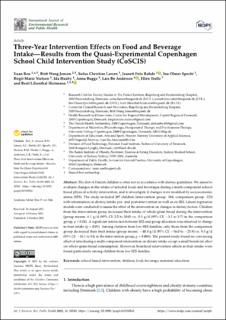| dc.contributor.author | Ren, Xuan | |
| dc.contributor.author | Jensen, Britt Wang | |
| dc.contributor.author | Larsen, Sofus Christian | |
| dc.contributor.author | Rohde, Jeanett Friis | |
| dc.contributor.author | Specht, Ina Olmer | |
| dc.contributor.author | Nielsen, Birgit Marie | |
| dc.contributor.author | Husby, Ida | |
| dc.contributor.author | Bugge, Anna | |
| dc.contributor.author | Andersen, Lars Bo | |
| dc.contributor.author | Trolle, Ellen | |
| dc.contributor.author | Heitmann, Berit Lilienthal | |
| dc.date.accessioned | 2022-02-16T09:33:43Z | |
| dc.date.available | 2022-02-16T09:33:43Z | |
| dc.date.created | 2022-01-06T14:58:54Z | |
| dc.date.issued | 2021 | |
| dc.identifier.citation | Ren, X., Jensen, B. W., Larsen, S. C., Rohde, J. F., Specht, I. O., Nielsen, B. M., . . . Heitmann, B. L. (2021). Three-Year Intervention Effects on Food and Beverage Intake—Results from the Quasi-Experimental Copenhagen School Child Intervention Study (CoSCIS). International Journal of Environmental Research and Public Health, 18(19):10543. | en_US |
| dc.identifier.issn | 1661-7827 | |
| dc.identifier.uri | https://hdl.handle.net/11250/2979279 | |
| dc.description.abstract | The diet of Danish children is often not in accordance with dietary guidelines. We aimed to evaluate changes in the intake of selected foods and beverages during a multi-component school-based physical activity intervention, and to investigate if changes were modified by socioeconomic status (SES). The study included 307 children (intervention group: 184; comparison group: 123) with information on dietary intake pre- and post-intervention as well as on SES. Linear regression models were conducted to assess the effect of the intervention on changes in dietary factors. Children from the intervention group increased their intake of whole-grain bread during the intervention (group means: 6.1 g/d (95% CI: 2.2 to 10.0) vs. 0.3 g/d (95% CI: −3.1 to 3.7) in the comparison group, p = 0.04). A significant interaction between SES and group allocation was observed to change in fruit intake (p = 0.01). Among children from low SES families, only those from the comparison group decreased their fruit intake (group means: −40.0 g/d (95% CI: −56.0 to −23.9) vs. 9.3 g/d (95% CI: −16.1 to 94) in the intervention group, p = 0.006). The present study found no convincing effect of introducing a multi-component intervention on dietary intake except a small beneficial effect on whole-grain bread consumption. However, beneficial intervention effects in fruit intake were found particularly among children from low SES families. | en_US |
| dc.language.iso | eng | en_US |
| dc.publisher | MDPI | en_US |
| dc.rights | Navngivelse 4.0 Internasjonal | * |
| dc.rights.uri | http://creativecommons.org/licenses/by/4.0/deed.no | * |
| dc.title | Three-Year Intervention Effects on Food and Beverage Intake—Results from the Quasi-Experimental Copenhagen School Child Intervention Study (CoSCIS) | en_US |
| dc.type | Peer reviewed | en_US |
| dc.type | Journal article | en_US |
| dc.description.version | publishedVersion | en_US |
| dc.rights.holder | © 2021 by the authors. | en_US |
| dc.source.volume | 18 | en_US |
| dc.source.journal | International Journal of Environmental Research and Public Health (IJERPH) | en_US |
| dc.source.issue | 19 | en_US |
| dc.identifier.doi | 10.3390/ijerph181910543 | |
| dc.identifier.cristin | 1976042 | |
| dc.source.articlenumber | 10543 | en_US |
| cristin.ispublished | true | |
| cristin.fulltext | original | |
| cristin.qualitycode | 1 | |

